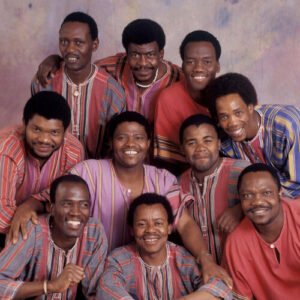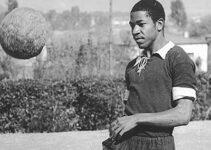As the sun rises on February 13th in South Africa, we have an opportunity to delve into the nation’s vibrant tapestry of history. Let us take a journey back in time to explore significant events that have unfolded on this date, offering glimpses into the rich and complex past of the country.

2005: Male choral group Ladysmith Black Mambazo win a Grammy Award
Ladysmith Black Mambazo is a South African music group that has gained worldwide recognition for their unique Scathamiya and Mbube genres. The group was formed in 1960 and released their first album in 1973, originally named Ezimnyama. However, group leader Joseph Shabalala changed the name to Ladysmith Black Mambazo, which he felt was more fitting after the group’s success in competitions. Their international stardom began in 1986 when they collaborated with Paul Simon on his album Graceland, which went on to win three Grammy Awards. In 2005, Ladysmith Black Mambazo won their second Grammy Award for their album Wenyukela, which went platinum in the United States. The group has had many highlights in their career, including collaborating with international star Josh Groban and performing at President Nelson Mandela’s inauguration.
1995: Madikizela Mandela is accused of misuse of funds
South Africa’s deputy minister of arts, culture, science, and technology and the ANC Women’s League president, Nomzamo Nobandla Winnifred Madikizela-Mandela (Winnie), was accused of misusing R500 000 presented to her by Pakistani Prime Minister Benazir Bhutto in 1994. Eleven League members who left the organization in protest of her leadership style made the claim.
1990: Fifty killed over three days during Inkatha
Fifty people were killed over three days in battles between Inkatha Freedom Party (IFP) and United Democratic Front (UDF) supporters in Natal, South Africa, following the release of Mandela on February 11, 1990. One of the reasons for this violence is that pro-government forces, as well as members of the South African security establishment, wished to destabilise and totally disrupt the negotiations between the African National Congress (ANC) and other political formations and the Apartheid regime. A further reason was that the UDF was growing in popularity in Natal, which was traditionally considered an Inkatha stronghold. The release of Nelson Mandela on February 11, 1990, intensified the violence. It was also during this period that rumours of a Third Force emerged, and much of the instability and political violence of this period were blamed on these elements. The transitional talks culminated in the first democratic election on April 27, 1994, eventually ushering in a democratic South Africa.
1990: Mike Gatting’s rebel cricket tour is curtailed
Negotiations between the National Sports Council (NSC) and the white South African Cricket Union (SACU) on the rebel cricket tour by Mike Gatting’s England team, culminated in Dr Ali Bacher’s statement on February 13, 1990. The SACU decided to shorten the tour due to political reasons. The number of games was reduced from seven to four and the second test match was canceled along with the second leg of the tour. NSC agreed not to hold protests at the remaining matches. The announcement was made on 14 February 1990 by Bacher.
1984: Gang leader Andre Stander is shot dead in the United States of America
A United States of America (USA) police officer, Michael van Stetina, shot and killed Andre Stander, a former police officer, South African fugitive, and the leader of the Stander Gang, which also included Patrick Lee McCall, Allan Heyl, and Stander himself. Stander was confronted by Van Stetina and got embroiled in a scuffle over Van Stetina’s shotgun, which resulted in him being shot. He died on the wet driveway to his apartment block while waiting for an ambulance. After police shot and killed McCall during a raid on one of the apartments in Johannesburg where he was hiding, Stander fled to the USA. Heyl fled to Europe and was later caught in England. The gang of three had become notorious, particularly after they robbed three banks in less than an hour in January 1984.
1982: Neil Aggett is buried in Johannesburg
Neil Aggett, the former organiser of the Food and Canning Workers Union and the African Food and Canning Workers Union, was buried in Johannesburg. It was estimated that 15,000 people attended his funeral. His labour organisation issued a call on February 11, 1982, that on the day of his burial, all workers should stay away from work. About 7,000 FOSATU workers at the Uitenhage branch of Volkswagen responded. The presence of police did not stop mourners from reaffirming the struggle for which Aggett died by singing revolutionary songs. Aggett’s funeral was filmed as a symbol of the impact he had on people through labour issues and his community work. He became the 51st person to die in police detention, and was the first White person to die under those circumstances since 1963. Police alleged that he had committed suicide by hanging himself with a scarf; however, the inquest on June 29, 1982, revealed that he had died as a result of police torture.
1901: Efforts to End the Anglo Boer War fail
Lord Kitchener meets with General Louis Botha in an effort to end the Anglo-Boer War, but Botha finds the British conditions unacceptable. The battle of Wolwekuil is fought the same day.
1850: The Childe Herold is shipwrecked
The Childe Herold is shipwrecked The Childe Herold is shipwrecked off Dassen Island. A 463-ton British wooden ship, the Childe Herold, en route from Bombay to London is wrecked off Dassen Island. It was carrying more than 1 300 pieces of ivory.
1713: Smallpox Epidemic Strikes at the Cape
A smallpox epidemic strikes the refreshment station at the Cape after arriving with the crew on a Dutch ship. The disease wreaks irreparable havoc amongst the indigenous and colonist populations of the Cape Peninsula and adjacent interior. The hardest hit are the indigenous Khoisan people. They appear to have much less resistance to the disease than the slaves and the colonists have and they suffer huge losses to their numbers.



